Guatemala Civil War
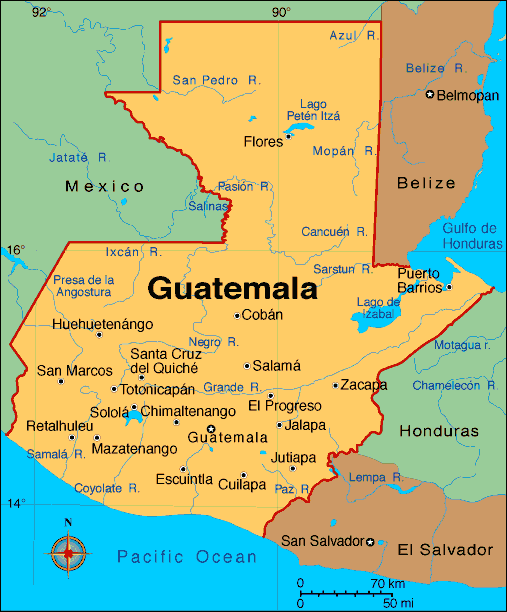
Successively replacing each other at the head of the country after the events of 1954, the proteges of military groups firmly followed the prescribed course of foreign and domestic policy. Such a follow-up (and chronic problems with the economy) to the beginning of the 1960-s caused dissatisfaction among army officers, the applied point of which was the opening of camps for training Cuban immigrants in the country. In mid-November 1960, a reformist group from the officer corps (the so-called "Jesus Company") attempted a military coup, brutally suppressed. Nevertheless, it was from this spark that the flame burned. Interestingly, unlike all other rebel movements in the region, it was not Marxists, not Communists and not leftists who created this, but two of the officers who participated in the coup, who did not accept defeat and created the November Revolutionary Movement named after 13 (Spanish abbreviation MP-13 ), the rebel organization to overthrow the military dictatorship, the de facto established in the country. It is curious that both officers had previously been trained at Fort Benning and the School of the Americas, American educational institutions, where, under the guise of radio technicians and drivers, they trained specialists in the fight against insurgent activity, and sent there, as a rule, the most loyal ones.
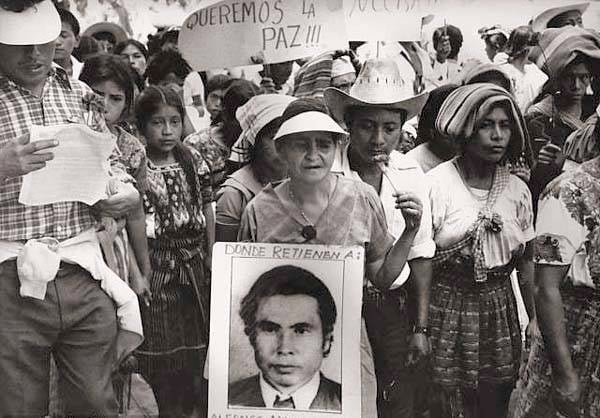
In 1962, leftist formations appeared in the selva, the October 20 Detachment, created by the Guatemalan Labor Party (GPT, the former Communist Party) and the April 12 Student Movement (after the peaceful demonstration was shot in April). At first they didn’t get lucky, and small squads were easily dispersed by the police and the army. From the first defeats, lessons were learned, and all opponents of the regime joined forces under the banner of the PAR (“rebel armed forces”). This stage of organizational design did not become the last, and even more so, permanent factionalism became a sign of Guatemalan insurgence. All this did not particularly contribute to military successes, and in 1963-66. the movements were engaged in small-scale activity - they acted against informers, especially cruel security officials, carried out sabotage against the property of oligarchs and Americans, seized settlements in the north of the country for several hours.
Some hope for positive developments came with the coming to power of a lawyer and university professor Julio César Mendez Montenegro, but his administration soon turned into a “civil facade” of the same military dictatorship, which did not hesitate to choose means. The very first week after the inauguration of Montenegro was marked by the disappearance of prominent members of GPT in an unknown 28 direction - the first such massive action. The students who opposed this practice were themselves pressed in the same way. Attempts by the PAR to achieve clarification of their fate in exchange for the three major officials who were taken hostage did not lead to anything. History with the disappearance of politicians, it showed how far there are at least some constitutional guarantees, rights and freedoms in the country, and the underground decided to shift the focus in its activities to the guerrilla struggle in the countryside.
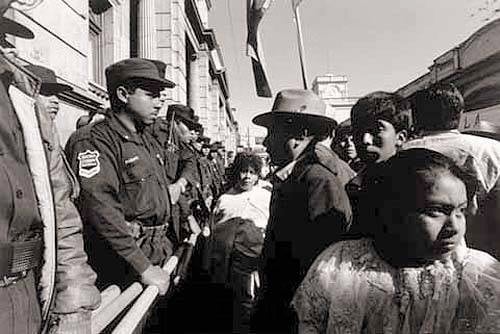
However, if such open massacres occurred in the capital, then outside of the military there was no incentive to restrict themselves in the methods, and in the second half of the 60-x, the “fighters against communism” came in with napalm and other potent means. The time of the “gentleman's war,” as the after-events dubbed the events of the first half of the 60's, was over. In the process of large-scale stripping of the rebel area in the department of Zacapa in 1966-67, about 300 rebels and more than 3 thousand civilians died. It should be particularly noted that during these years, the United States spent an average of 5 million dollars a year on arming and equipping the Guatemalan army and sent its advisers under the guise of “archaeologists”, “social workers”, etc. In the interests of the case, Guatemala was sent with military of Mexican or Puerto Rican origin so that their presence would be so conspicuous. As a result of the brutal repressions, the rebels moved their activities into the jungles of the northern part of the country and into the cities, where they dealt with local security forces, as well as diplomats and businessmen from the United States and allied countries.
With 1970, the rule of "presidents in uniform" began; The first of their pleiad was Colonel Arana Osorio, nicknamed for his “successes” in Zacap as the “Butcher of the Sacapa”, who occupied the presidency. Under him, the exploitation of indigenous people and illegal cases against them by local landowners became widespread - the removal of land and illegal levies more often, and opposition to such practices by the Indians themselves was an appeal to death squads. In 1971, only the official press counted 959 political assassinations, 194 "disappeared" (in the first three years of Osorio's rule, according to other sources, about 15000 were killed or "disappeared"); during the years of Osorio’s rule, 10% of MPs were missing or killed.
In 1974-78 The country was led by General Laugerud Garcia, whose election victory was secured with the help of an administrative resource. The illegitimacy of the regime forced him to refrain from the squall of reprisals that was usual for the new government in Guatemala; he even carried out some reforms, the activity of the opposition was allowed at a level almost reaching 1954 of the year, and the trade unions were allowed to solve labor issues in a court of law, and not get shot in the head. However, at the end of the general’s reign, a reverse turn was made. In 1977, an unprecedented strike by miners struck, and in the same year, parents of a missing student named Robin Garcia organized mass protests of students in parks and around government buildings, newspapers also spoke in their favor, and the funeral of a mutilated the bodies turned into a 50-thousandth demonstration with red carnations, a universal symbol of the struggle. Following this, the old methods of working with the opposition began to return. Only in August of the same year, the death squad works were missing or more than 60 opponents of the regime were killed.
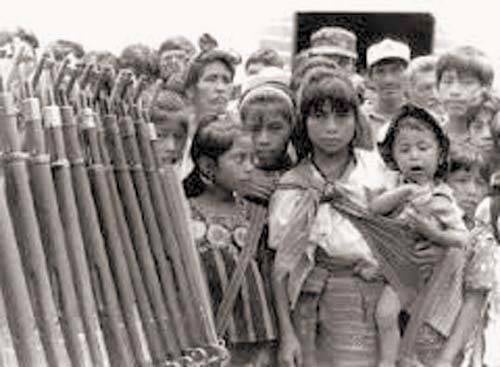
The next military to wear a presidential ribbon was General Fernando Romeo Lucas Garcia. 60% of voters did not come to the polls, and 20% of the ballots were also destroyed by voters in protest. All three candidates were outraged by fraud, and since none of the candidates got 50%, it was decided that the congress should decide on this issue. He acknowledged, despite the threats of the other two candidates (but Lukas Garcia had the support of Laugerud and his administration) by President Lukas. Having come to power, the winner ordered 5000 to be shot down by the opposition, including 76 political opponents of the regime. The beginning of the reign of Lucas García was marked by strikes; in August-October, residents of the capital were on strike, demanding to abolish the two-fold increase in public transport fares. The passions were so great that at that time graffiti on the theme of revolution began to appear on the walls in a multitude. In the end, the government retreated and the price remained the same. However, almost immediately, the Secret Anti-Communist Army, the most important death squad at the end of 70, announced the list of 38 opposition members to be eliminated, and was actively getting down to business, with the student leader being shot right at the end of a speech at a rally in the presence of many thousands of witnesses. In some cases, the killers used helicopters and other military equipment, which left no doubt about their ties with the military.
In 70's, the left tried to act by political means, but this did not bring positive results. By the end of the 70-x, they had to re-enter the field, mainly in response. This time, the partisans transferred activity not to the eastern, but to the western regions of the country. The government army immediately proceeded first to selective assassinations, and then to mass repressions. In January, 1980, a group of Indians from Quiche and Iksil, came to the capital to demand an investigation into the killings in their region. Indians were advised on how to act, trade union and student organizations, which further aggravated their position in the eyes of the military. The Indians were denied the hearing of their case, and their legal adviser was shot dead near the police headquarters. In response, 31 January 1980, Maya 39 seized the Spanish embassy, demanding a revision of the government’s position on the Indians. Given the popularity of the Sandinistas in its time with such actions, it was decided not to enter into any negotiations at the meeting of the President with the security forces. The police deliberately threw an explosive device into the lobby blocked by the Molotov cocktails, then barricaded the door and refused to let the firefighters in, so that the military actually burned the embassy along with everyone inside and it became clear that they would not stop at anything any opposition. The only survivor was stolen from the hospital and killed.
During that year, Guatemalan death squads, the most famous of which was the White Hand squadron (and also Eye for an Eye, New Anti-Communist Organization), dealt with 63 student leaders, 41 professor, 4 clerics, 13 journalists. In fact, they turned the murders into a theater - they widely advertised lists of future victims, attached accusatory notes to the dead, etc .; they were very convenient means for the military to deny their involvement in the killings. One of the departments of military intelligence directly and was created for the killings under the guise of a death squad.
Outside the cities, and therefore, out of sight of international organizations and the media, things were even worse. 29 May 1978 was the first massacre of civilians by deterrent against insurgents, in the village of Pengos (Alta Verapaz department); then this practice became common. In 1981, insurgents, allegedly inspired by affairs in Nicaragua and El Salvador, decided that their time had come, and began to recruit civilian supporters on a scale not seen before. This was followed by the widest offensive of Guatemalan rebels in history, accompanied by extensive sabotage with the help of civilian sympathizers. In response, the military resorted to massive recruiting of recruits, invested huge amounts of money by local standards into a network of informers and "military elders" in the field and in November 1981 began Operation Seniz ("ashes"), within which the military destroyed all villages on the way, striving to establish themselves along the Panamerican and simply to deface the zones of partisan actions. The rebels were unable to protect the Indian communes from army pressure — for example, in the sweeps from El Quiche north to the Mexican border, up to 15 thousand military personnel participated. Repressions became more and more widespread - in the 1980 year, the right made about 80 murders per month, and in 1983 during the days when Rios Montt came to power, more than 500. Unlike those who acquired ill-fame for torturing and detaining Salvadoran military, Guatemalans usually practiced murder and “disappearances” (“we have no political prisoners, only the dead”, as one oppositionist said). The latter helped greatly to mask the picture of what was happening, and the newspapers were given strict instructions not to publish any material on this issue.
Meanwhile, the 1982 election year was near, at which it was planned to carry out the transfer of power in the old ways - the government officially announced that it intends to treat everyone who does not vote as a rebel. But this time, General Efrain Rios Montt overthrew Lucas in March, a few months before the end of the presidential term, not allowing the idea to be put on the post of General Angel Anibal Guevara. Brigadier General, retired Montt, in his throne speech said that he had come to power by the will of the Lord, and he introduced the policy of "bean and rifle": if you are with us, we will feed you, but if not, we will kill you. In rural areas, the “constitutional guarantees” were “temporarily abolished” and “anti-subversion courts” established. The 46-82 Act repealed habeas corpus and such things as a signed arrest warrant, notification of the detainee’s relatives, public hearings and the right to appeal. The first month of Montt’s rule was the bloodiest in the history of the conflict - 3300 documented deaths, mainly in El Quich. After the first pressure in July, the 30-day amnesty was announced, which was used by about a hundred people. When the results were so unimpressive, the general promised the rebels to make a real war by launching a campaign called "Victoria 82". The military was ordered to pursue a scorched earth policy, according to instructions, for example, the village closest to where they came under fire was considered to be inhabited by enemies, and empty villages were inhabited by EGP and in a short time 400 villages were destroyed along with the population, the violence was carried out with particular cruelty - by burning alive, by chopping off heads, by kicking children about stones, rape was fully encouraged. They cracked down on both the rebels and their supporters, and even with their supporters and just passers-by. In addition to the actual military actions, measures of control over the population were introduced - food control was established, it was supposed to resettle people into “exemplary villages”, which, in theory, provide water, electricity, schools and churches, etc., really in “exemplary villages” there was nothing like it. In total, to 1985 in 23 villages resettled from 60 to 90 thousand; in some houses of the villages, due to the bad preparation of the project, 5-6 families lived. It was under Rios Montt that the 1981 created in XNUMX was expanded and fully encouraged. ostensibly spontaneously, but under the leadership of the chief of the general staff, a program for involving peasants in the orbit of pro-government activities, by organizing "civilian self-defense patrols" in the villages. All citizens aged from 15 to 60 years were required to periodically keep 24-hour watches to protect the territory from insurgents and catching refugees. On average, a village dweller visited the patrol once a week for a day, and the patrol participants often had to beat and kill their neighbors, so that they themselves would not pass for unreliable elements. Often the patrol used the case to settle accounts with their neighbors on the ethnic principle or for old offenses. For all 80-ies there was not a single case of punishment of a member of the patrol for their actions. Especially distinguished themselves were rewarded with land, property, crops, and women who were killed. Women from neighboring villages were very often forced to serve “self-defenders”, sometimes this “service” lasted for a year or more. Strictly speaking, the constitution, which denied unpaid enforced military service, outlawed patrols, but this did not particularly hinder them from continuing their activities.
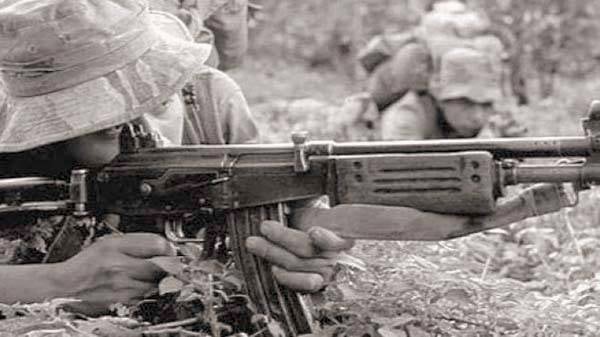
The second year of Montt’s rule (according to representatives of the Reagan administration, “completely committed to the ideals of democracy”), was somewhat more modest in terms of the scale of the killings. In general, during the reign of Montt, approximately 15000 people died (almost 43% of all known murders fell on his rule and 82% of all murders in rural areas, falling on years from 1979 to 1984), about a hundred thousand fled from the country, from 100 to 200, thousands became orphans, of which 20% were orphans, and the insurgency in general was reduced to the level of “hit-and-run”.
In response to the tightening of repression of 4, opposition groups in 1982. created a single movement - URNG ("Guatemalan Revolutionary Union"), it is also the "Quatripartita". It includes ORPA, EGP, PGT and EPR. It will be appropriate to explain in more detail the ideological positions and structure of groups. The EPRP (“the revolutionary organization of the armed people”), the only group that is not officially called a Markist, preferring the term “Guatemalan revolutionaries”, denied terrorism because it leads to retaliatory atrocities, stood for ambush and demoralization of the enemy, actively participated in various legal political organizations , but never under my own name, and generally disguised my activity in every way. She received cargoes from the Sandinistas first based on the coast and in Guatemala City, and in 80s she existed mainly in the western departments of San Marcos, Solola and Quetzaltenango. Rodrigo Asturias Amado, the commander of the EPRP, was the son of the writer Asturias, who took Mr. de Herr "Gaspard Hail". The EGP (“the partisan army of the underprivileged”) was created in the middle of 70's by activists of the HEADLIGHTS and GPT; The most remarkable of the political program, and the most frightening for opponents, should be called the postulate that the basis of all evils is private property. The party made public its policy document by the Nicaraguan method - took Romero's nephew hostage and demanded to publish a communique in exchange for his life. The head of the organization was Ricardo Ramírez de Leon (Mr. de Gerr "Rolando Moran"). The bases were the departments Ikschan and Iksil, then the organization’s activities spread to the south coast and to the capital. PGT (“Guatemalan Labor Party”) continued the work of the Guatemalan Communist Party, advocated the establishment of socialism, adopting the following program for the future at the 4 Congress: social justice, human rights, the struggle against the suppression and enslavement of national sovereignty. The command at the end of 70 was carried out by José Alberto Cardoza Agillar (Mr. de Herr "Mario Sanchez" and "Comandante Marcos"). After all the splits, misfortunes and storms that continued to struggle, the HEADLIGHTS was to create a truly democratic and popular government, and the two main slogans were “land for those who work” and “end exploitation and oppression!”. The commander of the group was Jorge Ismael Soto Garcia (Mr. de Herr "Pablo Monsanto" and "Manzana"). It is curious that PGT had a star with hammer and sickle on its emblem, while the PAR had a sculpture “Worker and Collective Farm Girl”. All groups were divided into fronts, which, according to tradition, were named in honor of fallen comrades and events of the past, with the EGP calling its formations after the names of persons of international renown - Sandino, Sapata, Ho Chi Minh. In the second half of 80, tactics of attacks on the export sector of agriculture were used by the government, which caused a lot of problems to the government, although the attacks themselves were undertaken by rather limited forces: as of 1990, the URNG consisted of 800-1100 people, of whom the EPR seemed 300-400, PHAR 300-400, ORPA 200-300. The chronic relative small number of insurgents is explained by brutal persecution (Guatemalan regimes acted much tougher than, for example, Salvadoran) and the lack of sources of external assistance, if we exclude irregular support from Cuba and Nicaragua. El Salvador and the Sandinistas were supplied more efficiently and regularly.
Separately from the insurgents proper, the Peasant Unity Organization existed, which appeared in 1978, fought for the rights of the peasants and informed the urban community about the outrages in the village. There were still Communes of resistance of citizens who began to form with the 1984 of the group of terror-affected peasants - quite a few people did not surrender to the authorities and did not get involved where, but wandered through inaccessible highlands or wild jungle, growing food and cattle or existing on wild vegetables. Every week or two or three days, settlements changed their location, built temporary shelters of large leaves (“pox”), provided their territory with traps and patrols, and the close presence of partisans prevented the military and patrols from getting down to business as usual. Over the decade, the population of such communes ranged from 17 to 30 thousand.
Despite the atrocities and rivers of blood, Montt is perceived by many even today as a savior from communism, putting an end to the opposition. However, General Montt regime was overthrown in August 1983. It should be a little more to say about the reasons for this. The fact is that the general was extremely pious, and being a pastor in the Protestant “Church of the Word” before the coup, eventually became a television preacher, constantly speaking with prayers and calls to come to Christ and be saved; He had his own TV program, coming out at night on Sundays. This was very strangely perceived in a traditionally Catholic country. Rios Montt was dismissed as a result of a coup under the leadership of General Mejí, the coup cost 7 dead and was declared a necessary measure against "religious fanatics" who desecrate government posts, and "comprehensive corruption." Under the new general, steps were taken towards the return of power in the country to civilians, however, the situation with human rights did not change much, each month there was about 100 political assassinations and 40 abductions.
The Reagan administration all this time supported and protected the military regime, hopelessly far from the ideals of democracy, allowed Guatemala to acquire a large number of jeeps and trucks in 1981, for which it temporarily added these to the list of non-military items, and in 1983 the embargo was canceled, and then the sale of spare parts for aircraft and helicopters of the types that were commonly used in counter-rescue combat was immediately committed, and the allocation of 300 thousand dollars to the trained through the congress ie the Guatemalan army. As of January 1985, the report of human rights advocates expressed the view that the United States "is more concerned with improving the image of Guatemala than with improving the human rights situation in it". It has now become fashionable to nod to Cuba as an example of the poverty caused by the Communists. It is necessary, however, to imagine that things in those countries of the region where the communists did not have power are much worse, even considering the billions of dollars that the United States invests in them. Can one say without shame that the average standard of living in Cuba has fallen during the years of socialism? Does anyone dare to say that the Communist government of Fidel Castro killed more people than Guatemalan “presidents in uniform”? But in the region there is not one country like Guatemala! And in fact, at least, the Cubans, in contrast to the subjects of pro-American regimes, in addition to the “dictatorship” have free health care and schools (and the literacy rate there is 20 percent higher than the average for the region), and no one is hungry for death, although in the conditions of a tough blockade by the Americans, the introduction of which by any other state against any other state of the United States would, without doubt, be strongly condemned.
In 1985, the Americans nevertheless went to drastic measures, threatening in case of refusal to transfer power by civilian cessation of military aid, and now the generals, unlike the middle 70's, could not refuse it; In the ensuing election, the first civilian president, Vinicio Cerezo, came to power in 20 for years.
He was allowed by the military to remain in office, but the president had to leave his thoughts about negotiations with URNG. The army continued to act as before. At the end of 1987, a new offensive was carried out, at once in Quiche and on the south coast, in the same style as the 1982 offensive of the year, but smaller in scale. In August-September, 1989 passed a major campaign to seize student leaders who supported the URNG political platform, paying special attention to insisting on political dialogue and organizing teachers' strikes. The body of a psychologist student who had been in the hands of the security forces wore marks from extinguishing cigarettes, needle marks, fingernails were torn out, and signs of group rape were present. However, since the rebels went into the woods, and the students protested on the streets not because they were terribly attracted to Marxism, but because of the despair caused by the economic situation and lack of rights, they couldn’t eradicate the partisans with bare force, and wanted to.
In 1990, Jorge Serrano Elias, ombudsman, the country's second elected president, came to power. Immediately after taking office, he established a cabinet-level human rights commission. Against the background of human rights rhetoric, the military was not particularly zealous, and the bulk of the crimes at the beginning of 90's were committed by self-defense patrols with the knowledge and encouragement of the army. In April, 1991, the president, led negotiations with URNG, but things were going so slowly that in February, 1993, the US, chopped off economic aid to Guatemalans, demanding that they sign a peace agreement as soon as possible. In addition, Americans were annoyed by the lack of progress on the cases of their disappeared citizens in Guatemala. Finally, under pressure and with reservations in March 1994, a preliminary peace treaty with the rebels was signed, with the active participation of the mediating countries, followed by almost a dozen treaties relating to different sides of the process. The next president, Alvaro Arzu, elected in 1995, took the matter much more actively, and 19.9.96 signed the last of the outlined preliminary agreements. 4.12. the parties formally renounced the use of force in Oslo, 19.12. The Assembly ratified the “law of national reconciliation”, according to which all participants in the war were amnestied, except for the organizers of genocide, torture and “disappearances”. The conclusion of a peace treaty was welcomed by a huge crowd and a march through the streets of Guatemala. The Guatemalan civil war cost 34 years for thousands of years (about a quarter of them are missing) in 200 years, and from 80 to 93% of the deceased on account of the government army.
7 April 1997 earned a “Project to Recover Historical Memory”, which, under the leadership of the Catholic Church, began collecting evidence of human rights violations during the war. The fate of the main author, Bishop Juan Gerardi, was a couple of days after the report on violations was killed on the street "11 with blunt object blows" tells how it’s not liked the persons involved in the report. Although the process was slow and 30.11.98 took place. The first formal judicial conviction of those guilty of atrocities during the civil war, namely three members of the “self-defense patrols” involved in the 269 killings in 1982, took place, all three were sentenced to death. In February, 1999 was followed by a report by the UN Commission on human rights violations during the war, which in total recorded 29 thousand documented “disappearances”. Of this number, only 3-4% is accounted for by the rebels. Described in the report confirms the tendency of the military to massacres in rural areas, since it proved to be more effective than one-by-one murder, because in the second case, the relatives of the deceased were ready-made material for the rebels. A large percentage of victims are rural teachers, social workers, health care workers, since these were all agents of influence and agents of change. The bulk of the victims were persons from 20 to 25 years old, the second largest group 25-30.
Few of the military actually answered for the evil. The case against Montt himself and the ban on his participation in the presidential election-2003 had to be canceled, as the right in droves began to rally civil disobedience, putting the country on the verge of resuming the civil war. The preacher-general lost the election, but showed that the conflict potential in Guatemala is very high. And yet, according to relatives of one of the many victims, “it’s still nice to see Montt and the others shaking with fear in the dock, and it’s nice to know that they too will experience some of what they have prepared for our loved ones. I know that justice will ever triumph! ”
Information